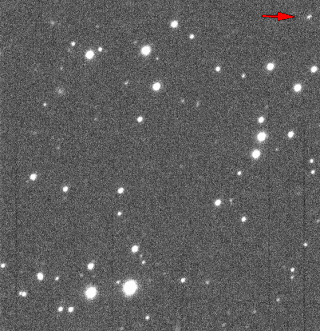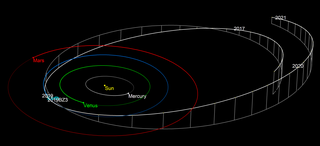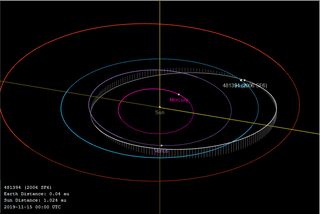Related Research Articles
(417634) 2006 XG1 provisional designation 2006 XG1, is a sub-kilometer asteroid, classified as near-Earth object and potentially hazardous asteroid of the Apollo group, that had a low but non-zero probability of impacting Earth on 31 October 2041. The asteroid was discovered on 20 September 2006, by astronomers of the Catalina Sky Survey, using a dedicated 0.68-meter telescope at Mount Lemmon Observatory in Arizona, United States.
(6037) 1988 EG, is an eccentric, stony asteroid, classified as near-Earth object and potentially hazardous asteroid. It belongs to the group of Apollo asteroids and measures approximately half a kilometer in diameter. It was discovered by American astronomer Jeff T. Alu at the U.S. Palomar Observatory, California, on 12 March 1988.
(101869) 1999 MM, provisional designation 1999 MM is a sub-kilometer asteroid on an eccentric orbit, classified as a near-Earth object and potentially hazardous asteroid of the Apollo group. It was discovered on 20 June 1999, by the Lowell Observatory Near-Earth-Object Search (LONEOS) at its U.S. Anderson Mesa Station in Flagstaff, Arizona. The first observation was made by Catalina Sky Survey just 8 days before its official discovery.

(511002) 2013 MZ5, provisional designation 2013 MZ5, is a sub-kilometer asteroid, classified as a near-Earth object of the Amor group, estimated to measure approximately 300 meters (1,000 feet) in diameter. It was discovered on 18 June 2013, by astronomers with the Pan-STARRS survey at Haleakala Observatory on the island of Maui, Hawaii, in the United States. It was the 10,000th near-Earth object ever discovered.
(523662) 2012 MU2, provisional designation 2012 MU2, is a sub-kilometer asteroid on an eccentric orbit, classified as near-Earth object and potentially hazardous asteroid of the Apollo group. It was discovered on 18 June 2012 by astronomers of the Catalina Sky Survey at an apparent magnitude of 19.9 using a 0.68-meter (27 in) Schmidt–Cassegrain telescope. It has an estimated diameter of 240 meters (790 ft). The asteroid was listed on Sentry Risk Table with a Torino Scale rating of 1 on 23 June 2012.
(391211) 2006 HZ51 is a bright, sub-kilometer asteroid on an eccentric orbit, classified as a near-Earth object and a potentially hazardous asteroid of the Amor group. It was discovered on 27 April 2006, by astronomers of the Catalina Sky Survey conducted at Mount Lemmon Observatory, Arizona, United States. During preliminary observations, it was thought to have a small chance of impacting Earth in 2008. The asteroid measures approximately half a kilometer in diameter and has an exceptionally high albedo.
2014 XL7 is a near-Earth object and Apollo asteroid, approximately 230 meters (750 feet) in diameter. It was the most dangerous potentially hazardous asteroid on Sentry Risk Table upon its discovery by the Mount Lemmon Survey in December 2014. At the time, the asteroid had a cumulative 1 in 83000 chance of impacting Earth on 4–5 June between the years 2048 and 2084. After the object's observation arc had been extended to 35 days, it was removed from the Sentry Risk Table on 15 January 2015. Since then the asteroid's orbit has been secured. Although it has an Earth minimum orbit intersection distance of less than one lunar distance, there are no projected close encounters with Earth in the foreseeable future, with its closest passage to occur in May 2046, still millions of kilometers away.
(456938) 2007 YV56, provisional designation 2007 YV56, is a sub-kilometer asteroid on an eccentric orbit, classified as a near-Earth object and potentially hazardous asteroid of the Apollo group, approximately 190–360 meters (620–1,200 ft) in diameter. It was discovered on 31 December 2007, by astronomers of the Catalina Sky Survey conducted at the Catalina Station in Arizona, United States.
2017 TD6 is a micro-asteroid, classified as a near-Earth object of the Apollo group, approximately 10–20 meters in diameter. It was first observed by Pan-STARRS at Haleakala Observatory, Hawaii, on 11 October 2017.

2017 XO2, also written 2017 XO2, is a sub-kilometer asteroid and near-Earth object of the Apollo group approximately 110 meters (360 feet) in diameter. The asteroid was discovered by Pan-STARRS in December 2017, after it already had approached Earth at 0.051 AU (7,600,000 km) or 20 lunar distances (LD) on 6 November 2017. On 26 April 2057, it will pass Earth at a similar distance of 21 LD again.

2018 CN2 is a very small asteroid, classified as a near-Earth object of the Apollo group, approximately 5 to 16 meters in diameter. It was first observed by astronomers of the Mount Lemmon Survey at Mount Lemmon Observatory, Arizona, on 8 February 2018, one day prior its close encounter with Earth at 0.18 lunar distances.

(505657) 2014 SR339, provisional designation 2014 SR339, is a dark and elongated asteroid, classified as near-Earth object and potentially hazardous asteroid of the Apollo group, approximately 970 meters (3,200 feet) in diameter. It was discovered on 30 September 2014, by NASA's Wide-field Infrared Survey Explorer telescope (WISE) in Earth's orbit. Closely observed at Goldstone and Arecibo in February 2018, it has a rotation period of 8.7 hours.

2018 CC is a micro-asteroid, classified as a near-Earth object of the Apollo group, approximately 20 meters (70 ft) in diameter. Its official first observation was made by the Catalina Sky Survey at Mount Lemmon Observatory, Arizona, United States, on 4 February 2018. Two days later, the asteroid crossed the orbit of the Moon and made a very close approach to Earth.

2019 BZ3 is a very small near-Earth asteroid of the Apollo group, approximately 6 meters (20 feet) in diameter. It was first observed by the Mount Lemmon Survey on 28 January 2019, just hours after the asteroid's sub-lunar flyby of Earth at less than 0.12 lunar distance.
2019 OU1 is a sub-kilometre asteroid, classified as a near-Earth object of the Apollo group. On 28 August 2019, the object safely passed 1.028 million kilometres from Earth, travelling at around 13 km/s (47,000 km/h).

(481394) 2006 SF6 is a sub-kilometer near-Earth object and potentially hazardous asteroid of the Aten group, approximately 300 meters (1,000 feet) in diameter. It was discovered on 17 September 2006, by the Catalina Sky Survey at Catalina Station in Arizona. On 21 November 2019, it passed Earth at a distance of 11 lunar distances (0.0288 AU), which is the object's closest flyby for centuries. The stony A/S-type asteroid is highly elongated in shape and has a rotation period of 11.5 hours.
2017 QC36 is a near-Earth object and a potentially hazardous asteroid of the Aten group, It measures approximately 200 meters (660 feet) in diameter and was briefly observed by the Wide-field Infrared Survey Explorer on 18 August 2017 before it became a lost asteroid on the following day. It was later recovered in 2021 from archival Pan-STARRS and Cerro Tololo observations.
2021 AV7 is a near-Earth asteroid of the Apollo group, discovered by astronomers Alain Maury and G. Attard at San Pedro de Atacama, Chile on 15 January 2021. With an estimated diameter of 450–1,000 m (1,480–3,280 ft), it is considered a potentially hazardous asteroid. It has a highly elliptical orbit that brings it within Earth's orbit. Although its nominal orbit has a small minimum orbit intersection distance around 70,000 km (43,000 mi) from Earth's orbital path, the asteroid does not make any close approaches within 0.2 astronomical units (30×106 km; 19×106 mi) over the next 100 years.
2020 SL1 is a near-Earth asteroid of the Apollo group, discovered by the Pan-STARRS 1 survey at Haleakala Observatory, Hawaii on 18 September 2020. With an estimated diameter of 0.9–2.0 km (0.56–1.24 mi), it is the largest potentially hazardous asteroid discovered in 2020.

2022 RM4 is categorized as a potentially hazardous asteroid because it is around 400 meters in diameter and makes close approaches to Earth. It was discovered on 12 September 2022 when it was 0.61 AU (91 million km) from Earth and located at declination +65 near the northern circumpolar star Zeta Draconis.
References
- 1 2 3 4 5 6 7 "2012 UE34". Minor Planet Center. Retrieved 16 January 2020.
- 1 2 3 4 5 6 7 8 "JPL Small-Body Database Browser: (2012 UE34)" (2019-11-09 last obs.). Jet Propulsion Laboratory . Retrieved 16 January 2020.
- 1 2 3 "Asteroid Size Estimator". CNEOS NASA/JPL. Retrieved 9 February 2018.
- ↑ "Date/Time Removed". NASA/JPL Near-Earth Object Program Office. Archived from the original on 2 June 2002.